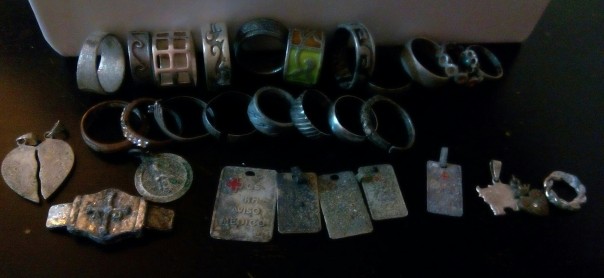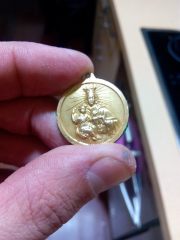Are you ready??
Publicado por topocastor
Ready to Hunt!!!
https://topocastor.wordpress.com

Publicado en Sin categoría
Metal Detecting with #nuggetnoggin in the Mud
Publicado por topocastor
In my opinion…the best hunter.
HH & GL
Publicado en Buscadores
Etiquetas: Detecting, Detector, Detectoring, Happy Hunting, Hunting, metal detecting, Metal Detector, Mud, NuggetNoggin
How to Hunt for Antique Toys With a Metal Detector (by Daniel Bernzweig)
Publicado por topocastor
Whether you played with them yourself, or you simply enjoy the quality and craftsmanship of
years gone past antique toys are a lot of fun! They were simple yet, they fed your imagination
and made for hours and hours of enjoyment. Antique toys are also something you just might be
able find with a metal detector. Here to tell us more about how metal detectors can be used to
unearth long, lost antique toys is Daniel Bernzweig of MetalDetector.com.
Finding antique toys with your metal detector is easy in that most toys made prior to the 1950s
were made of some type of metal. Steel, cast iron, tin, and even lead for a time were all used to
make antique toys throughout our recent history. Wood was also a popular material used for
toy construction during these times, but often, parts like wheel axles, bolts, and other
accessories were made of metal. Given this, these toys are prime targets for today’s metal
detectors.
Although they’re made of the right material, actually finding antique toys with your metal
detector is much less common than unearthing say, coins, or a piece of jewelry. These other
items were lost much more frequently than toys and by more people. However, if you look in
the right places and do your research you may just surprise yourself! Some ideas to get you
started include current and former parks and schools as well as old homesites.
Once you decide on a site where you have permission to go metal detecting, you’ll want to set
up your machine. A good relic hunting metal detector will help you easily target metal toys.
Remember, some metal toys were quite small, like toy soldiers for example. A medium search
coil will usually be what you want for this type of metal detecting so you can find all the small as
well as the larger toys. Also, a machine with a lower frequency may be particularly helpful in
identifying iron and steel toys. Although not necessary, a pair of metal detecting headphones
are quite useful when hunting antique toys in order to be sure you’re hearing even the deepest
signals.
In addition to these items you’ll also want to take a metal detecting shovel with you. These
shovels are compact, lightweight and easy to carry. You may consider a digging knife and a
pinpointing probe to help you zero in on your target as well. While these last two items aren’t
absolutely necessary, they’re helpful when hunting for relics like toys to help prevent you from
damaging the item when digging it up. You can never be sure exactly what’s under that ground
and the more you’re able to determine where you should dig in relation to the target the better
off your find will be in the end.
Now that you’ve got all your equipment and have chosen your destination, you’re ready to head
out and find some antique toys with your metal detector. Keep your ears open and dig all the
targets you can with care. You may just find a tin truck worth upwards of $1,000 or a cast iron
airplane – one of the most rare, and sought after antique metal toys around.
Biography
About the author: Daniel Bernzweig manages MetalDetector.com in Southborough, MA. He has written
on the subject of treasure hunting and metal detecting since the mid 1980’s. He enjoys traveling with his
metal detector and helping to educate others in the correct use of metal detectors in their explorations.
Publicado en Sin categoría
Etiquetas: antique toys, Detecting, Detector, Detectoring, Happy Hunting, Hunting, metal detecting, Old coins
My Metal Detecting Finds #silver #rings
Publicado por topocastor
Publicado en Sin categoría
Etiquetas: Detecting, Detector, Finds, metal detecting, Metal Detector, My finds Photos, RINGS, Silver
My Metal Detecting Finds (23/02/2015) #goldring
Publicado por topocastor
Perfect day in the rain, many peseta coins and euro, a silver ring, sterling silver and precious gold ring ….
Tomorrow prediction is very negative, very big waves, wind and rain .. .I think after tomorrow can be another great day.
Happy Hunting everyone¡¡
Publicado en Sin categoría
Etiquetas: Beach, Detecting, Detector, Detectoring, Espectacular, EUROS, Gold, metal detecting, Metal Detector, PESETAS, Silver, Temporal
My Metal Detecting Finds (20/02/2015)
Publicado por topocastor
Another good day in terms of search is concerned because the weather was not good, a rainy day but a good amount of coins and 4 pieces of silverHAPPY HUNTING¡¡¡¡
Publicado en Sin categoría
Etiquetas: Beach, Detecting, Detector, EUROS, Finds, metal detecting, Metal Detector, My finds Photos, PESETAS, Silver
My Metal Detecting Finds (19/02/2015)
Publicado por topocastor
GREAT DAY AT THE BEACH , SUNNY DAY , A LOT OF COINS , SILVER RINGS , JEWELRY, AND A GOLD NECKLACE , UNFORGETTABLE DAY….
Publicado en Sin categoría
Etiquetas: Beach, Detecting, Detector, EUROS, Finds, Gold, metal detecting, Metal Detector, My finds Photos, PESETAS, Silver, SUNNY DAY
10 Tips to Using Your Metal Detector Correctly
Publicado por topocastor
1. Ask for Assistance the First Time
If it is the investor’s first time using a metal detector, it is important for him to ask for assistance from the person he bought it from, or to read the manual thoroughly. This is important because every machine is different. They can have different sounds when they find different pieces of metal.
2. Practice Makes Perfect
Practice really does make perfect. Investors should practice with a few items until they become familiar with the different sounds that the device makes. For example, the investor can run the metal detector over a pull tab from a pop can, a nail, a coin, and over a gold ring to distinguish the various sounds the metal detector makes for each item. This will save the investor time when looking for specific items and prevent digging for unwanted objects. When beginning, move the metal detector slowly over the area being searched while keeping track of the area that has already been searched. Practice doing this on small pieces of ground at a time.
3. Train the Ear to Hear the Beep
It is important that investors train their ears to hear the different beeps. Place a gold ring and a penny on the ground; slowly run the detector over both of them, and listen for the difference in the beep. If a detector is set properly, the investor will hear a much stronger beep from the ring than from the penny. The investor should continue doing this for awhile until he feels confident in knowing the difference between a hit and just a small beep.
4. Search in a Pattern
Once an investor starts searching, it is important for him to work in an orderly pattern. This can be done by picking an area of choice and working it in a methodical way. There are various patterns that an investor could choose to use. One method that works for many is to do the border of the area first, all the way around, and then to search from left to right. The exact pattern is not as important as actually using one as it would be a waste of time to search an area that has already been covered. The pattern keeps the investor on track, and helps him to establish which ground he has searched and which ground still needs to be searched.
5. Navigate Exactly to Where the Artifact Is
It is important for the investor to really narrow down where the artifact is before deciding to dig. Not knowing precisely where the item is can make the digging process a whole lot longer. To narrow down the area, the investor should move the detector around side-to-side and front-to-back until he has a good idea of precisely where the object is. Digital detectors have an indicator screen that can help the investor really narrow in on the artifact. Once an investor decides to dig, use a plastic trowel to bring up a small area of the dirt. Put the grass and dirt into a bucket and then check the area again. It is important that the investor does not sift through the bucket until he is sure he has gotten the artifact out of the ground.
6. Get the Target Out of the Ground
When an investor finds something he really doesn’t care for such as a penny or a piece of foil, he should not just throw it back in the ground. Chances are that if the investor throws the target back into the ground, he will find it again later and dig up the same worthless piece. Simply put the target in a bag or in the trash, but never back into the ground.
7. Don’t Clean the Artifacts
The first response of new metal detector users when they find an artifact is to clean it up and find out what it is. Don’t clean it. Cleaning an artifact can lower its value. Simply use a soft brush to get rid of the residue from the dirt, rinse in clean water, and pat it dry. When an investor is in doubt, he can always just put it into a zipper bag until he can get a professional to look at it.
8. Use the All Metal Search Option
Many metal detectors allow the user to choose what type of treasure he is looking for such as rings or coins which makes the machine not beep when it comes across a pull tab from a pop can or nail. However, it is important that investors use the all metal search option. Using this option gives the investor a higher chance of finding jewelry or gold as gold has a low conductivity and if foil or nails are tuned out, the investor may miss out on the gold also.
9. Be Aware of Salt Interference
Salt can interfere with many metal detectors’ signals. It is important for investors to be aware of the salt at oceans and gulf beaches because of this fact. Metal detectors may need to have their sensitivity adjusted down so the signals are stabilized. This may cause the user to lose some depth; however, it allows the investor to continue searching for treasures without the interference of salt.
10. Wear Headphones
There are specific metal detector headphones that can be worn when treasure hunting. It is important for investors to wear headphones in order to enhance the experience. Headphones block out various other sounds such as wind, conversations, and radios and allow the investor to only focus on the beeps. They prevent the investor from disturbing others, and prevent kids or other nosey people from interrupting the investor.
Publicado en Sin categoría
Etiquetas: Advice, Consejo, Detecting, Detector, Metal Detector, tips
Detectie metale in Rumania #metaldetecting
Publicado por topocastor
Another country to the video collection….
HH & GL
Publicado en Buscadores
Etiquetas: Detecting, Detector, Detectoring, metal detecting, Metal Detector, Rumania
TV Program about Metal Detector
Publicado por topocastor
Good television program … » A tresure under your garden «
Publicado en Sin categoría
Etiquetas: Detector, France, metal detecting, Metal Detector, program, Tesoro, TRESURE, TV







